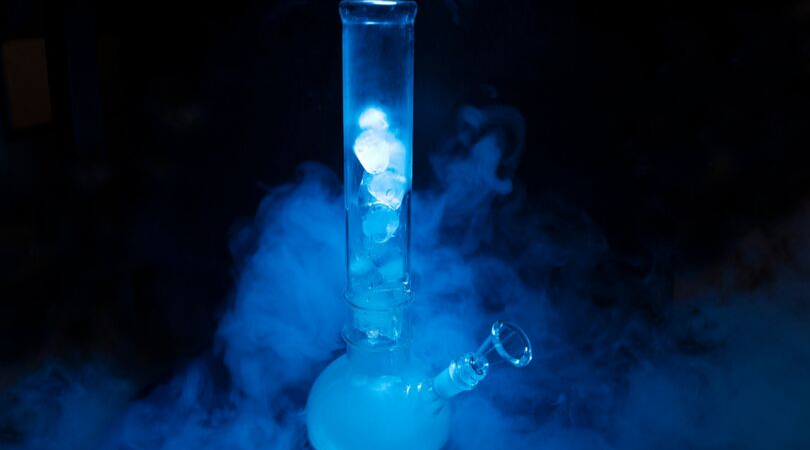
Bongs are well known for their ability to elevate the smoking experience to a whole new level. If you make a transition from joints to bongs, there’s a chance that you’ll never want to abandon the latter.
But why have these devices become so popular among both novice and experienced smokers alike?
You’ve probably found yourself wondering why smoking out of a bong makes your high so strong and clear while keeping the smoke cool and smooth.
What’s the science of how a bong works?
If you want to know exactly the mechanism behind water filtration offered by the bong, then this article is for you. Today, we explain the science of the bong — leaving no stone unturned.
But first up, let’s take a closer look at the bong itself.
What Is a Bong in the First Place?
A bong is one of the most iconic ways of consuming cannabis, especially when it comes to flowers. You can also use it to smoke other herbal products, but cannabis is hands down the most commonly consumed herb in the bong.
In essence, bongs are large water pipes consisting of a watertight bowl-stem, a water container, and a mouthpiece to inhale the smoke with. Bongs offer different water filtration systems, from a single naked base to advanced percolators.
The cannabis is placed at the top of the bowl and the user puts their mouth close to the mouthpiece to draw the smoke which is filtered through the water.
Bongs can take many shapes, sizes, colors, and designs. They also use different materials, including wood, bamboo, glass, silicone, or metal.

The vast majority of bongs are made from borosilicate glass, with manufacturers placing the same emphasis on the function as much as the design. But if you want, you can find yourself pieces made of pure gold and encrusted with diamonds. On the other hand, a bong can be created from a simple plastic bottle.
The History of the Bong in a Nutshell
Let’s start with the basic terminology.
The word “bong” originated from Thailand, where the natives were referring to cylindrical wooden tubes or pipes cut from bamboo as “baung”.
Another term for describing a bong is “water pipe”, but bongs are also recognized as bing, binger, pipe, or hookah.
Bongs have been in circulation for centuries, being an inherent part of cannabis culture — some people even give their bong a name.
But what are the first historical records of bong use?
Despite being mostly associated with the hippy era of the 1960s, the use of a water pipe for filtering the cannabis smoke dates as far back as 2400 years ago.
The earliest water pipe was discovered in the region of modern Russia. Since then, it has come a long way through Persia to China, crossing the famous Silk Road. Chinese royalty used the bong to smoke tobacco, preferring this inhalation method over the others.
What we known as the modern-day bong emerged during the 1960s and 1970s, when American glassblower Bob Snodgrass created a glass waterpipe, inventing the manufacturing method that gives bongs their many customization options.
Basic Components of the Bong
The classic bong consists of five components:
1. Bowl
Similar to the pipe, the bong comes equipped with a bowl, which is the bulbous part of the device. This is where you put your dried herbs and ignite them. The bowl is often detachable, which allows it to function as a carb to capture the smoke inside the tube.
2. Carb
Short for “carburettor”, the carb is a whole through which the user can pull the smoke from the bong chamber to the lungs.
3. Downstem
The downstem is a small tube where the smoke travels from the bowl to the base, before it gets filtered through the water.

4. Tube
The tube refers to the chamber that collects the smoke once it has been filtered through the water.
5. Base
The base is the bottom of the device and can take different designs. Usually, the water chamber is created by introducing a bubble or beaker shape. Some bongs include ice chambers and percolators for improved filtration and even lower temperature of the smoke.
6. Mouthpiece
The mouthpiece is where you place your lips and take a hit from the bong. It’s located at the top of the unit.
How to Smoke Out of a Bong
That’s pretty simple.
First, you need to make sure the bong is clean. You don’t want to smoke out of a dirty bong because it will taste disgusting and also entail certain health risks that we’re going to cover later in the article.
Next, fill the base of the bong with just enough water to create bubbling. Once done, grind your cannabis into small pieces and pack the bowl with the bud.
It’s time to light up the herb.
Grab a lighter, placing your mouth over the mouthpiece at the same time. Ignite the cannabis and inhale the smoke.

The whole tube of the bong should be filled with milky smoke by now. This is where you should remove the carb or the bowl and take the smoke right into your lungs.
The Science of How a Bong Works
Well, as with any smoking method, the purpose of the bong is to activate the THC and CBD in the flower through combustion so they can produce their effects. The heat changes the chemical structure of these cannabinoids by breaking down the extra carbon link in them.
Cannabinoids are then changed into gas contained in the cannabis smoke.
This is how smoking the herb works.
Below give you a detailed breakdown of the science behind using the bong.
1. Explaining the Water Filtration
The activation of cannabinoids isn’t the only thing happening when you burn cannabis. Combustion produces a smoke stream that carries lots of things you wouldn’t prefer to inhale, such as hot smoke, tar, and fine plant matter.
“Tar” is the umbrella term for the numbers of toxic substances released by cannabis combustion. The smoke contains plenty of polycyclic aromatic hydrocarbons that are dangerous for your lungs.
When the smoke enters the base of the bong, it gets filtered through the water, leaving many nasty substances away. Epidemiologic studies found that tobacco smokers who use a water pipe are much less likely to suffer from cancer than those who use traditional smoking methods.
Interestingly, researchers have never found a link between cannabis smoking and lung cancer.
The bong also cools the smoke immediately once it starts passing through the water. This, in turn, results in a smoother toke.

The water also filters out any ash and tiny plant particles that would otherwise blow into your airway.
The best indicator that your bong has done a good job at filtering the smoke is the color of the water, which eventually turns brown, as well as the inside of your bong’s base.
2. Does the Bong Really Capture More Cannabinoids & Terpenes?
There’s no doubt that the water filtration offered by the bong is effective, but does that mean you get a stronger and more flavorful hits from the device?
Not necessarily.
According to studies in California, bongs tend to filter more water-soluble psychoactive cannabinoids than tar and hydrocarbons, so the user would need to smoke more weed to get the desired effects because the ratio between tar and cannabinoid filtration leans more towards tar.
So are you losing any cannabinoids or terpenes as the smoke runs through the water?
Not in concentrations high enough to result in a different experience. That’s because THC and CBD aren’t soluble — nor are most terpenes.
That being said, if you want to revel in the aromas and flavors of your cannabis strain, the bong may be the best of all smokable consumption methods.
Aside from the lack of filtration, smoking a joint or blunt makes you inhale the contents of the rolling paper or blunt wrap. These usually come with synthetic additives that not only compromise the quality of your experience but also introduce another group of toxic substances to your body.
This isn’t a problem with the bong. Bongs capture more flavor in the smoke but they also cool it, so it’s much less harsh for the throat.
3. Why Is It Necessary to Clean Your Bong Regularly?
Keep in mind that the water in your bong can also change the nature of the smoke. If you’re inhaling from a dirty bong water, the smoke will taste like repelling resin. If the water has been chlorinated, that distinct flavor will carry through as well.
Why does this happen?
Because the gas is absorbing degraded particles from the dirty water, such as plant-based molecules that have undergone full oxidation upon combustion — and that exchange happens through the bubbles.

It’s not a one-way interaction.
That’s why it’s so important to maintain a proper cleaning routine over your bong (the same applies to dab rigs). You need to make sure that the base of your bong, as well as the bowl and other problematic areas, are shining clean if you want to enjoy a pure flavor.
The diffuser in the bong produces a lot smaller bubbles that create relatively high ratio between the surface area and volume, allowing for a more efficient exchange between the smoke and water. This ensures a greater degree of filtration.
4. Studies On the Science Behind Using the Bong
The studies on cannabis and bongs are very scant. However, the results from those studies have revealed some interesting data.
The aforementioned California study was conducted in the mid-1990s by NORML’s California state coordinator Dale Gieringer in collaboration with the Multidisciplinary Association for Psychedelic Studies (MAPS).
The research team wanted to compare the effectiveness of joints, bongs, and vaporizers. They discovered that unfiltered joints actually turned out better than bongs when it came to the amounts of delivered cannabinoids per unit of tar.
However, the main problems Gieringer noted back then was that they had to use low-quality marijuana supplied by the National Institute on Drug Abuse, with THC concentrations at around 2.3%, which is ridiculously low compared to the current market standards.
That little detail makes the methodology of the study questionable because consumers had to burn more material along with the unwanted byproducts to achieve the desired effects.
There’s also a literature review of past water pipe studies drawn out by Nicholas V. Cozi, a University of Wisconsin pharmacologist — the review covers research from the 1960s and 1970s.
Here’s how Cozzi concluded his findings:
“They [bongs] can be effective in removing components from marijuana smoke that are known toxicants, while allowing the THC to pass through relatively intact.”

As you can see, two different studies have brought contradictory results. The research is inconclusive and requires further investigation. Unfortunately, further studies on the bong and cannabis were not forthcoming, as scientists targeted their focus on studies of vaporizers as a healthier delivery method of cannabinoids.
Do You Know How a Bong Works Now?
The science of how a bong works is pretty simple. The purpose of this device is to filter the smoke from harmful compounds, deliver more cannabinoids to your body, and cool the smoke so you can reap the benefits from cannabis more effectively and with more flavor.
Bongs are also relatively simple to use. It only takes some fine-quality weed, a clean device, and clean bong water to get the most out of your herbal experience.
Whether the water filtration results in a stronger high is up for discussion, but smoking cannabis isn’t about getting baked like a muffin — we all should use the herb responsibly to fight the stigma imposed by decades of prohibition and fear-driven propaganda.
Before you smoke out of a bong, make sure your piece is clean enough to be used without a shame. Any chemicals in the water will loom a shadow over the taste and overall quality of your strain.
How do you make the most out of your bong sesh? Share your tips with us in the comments below!





